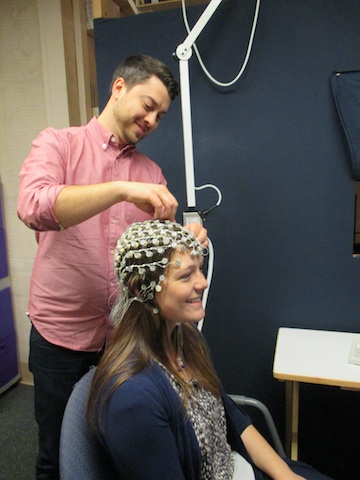This month, one of the articles discussed at the EEG Team Journal Club was ‘Experimental manipulation of face-evoked activity in the fusiform gyrus of individuals with Autism’, co-authored by our own Dr. Caitlin Hudac! In this study, researchers used fMRI brain scans and eye gaze manipulation to investigate neural activation in the fusiform gyrus (FFG, a part of the brain specializing in facial recognition) and the amygdala (a part of the limbic system that processes emotional reactions).
Aberrant eye contact is a common feature of Autism Spectrum Disorder (ASD). Eye-tracking experiments have identified atypical gaze patterns among individuals with ASD, specifically in response to social stimuli and faces. Similarly, atypical activation of the fusiform gyrus (FFG), fusiform face area (FFA) and the amygdala in response to social stimuli have been observed in a multitude of fMRI and brain imaging studies comparing ASD and typically developing (TD) participants.
Brain imaging research findings are mixed, however – some studies found a hypoactivation (a smaller response to stimuli) in these regions among the ASD groups, while others found equivalent or even hyperactivation. These discrepant findings may be due in part to the research methods employed in conjunction with underlying neural mechanisms. FFG and amygdala function might be impaired in ASD brains, but perhaps hypoactivation is occurring simply because individuals with autism aren’t looking at eyes or socially salient stimuli. In an attempt to address this posit, Perlman & colleagues manipulated eye gaze to see if FFG and amygdala activation could be normalized in ASD brains when participants were drawn to look at eyes.
12 adults with ASD and 7 TD adults completed an fMRI brain scan while looking at a picture of a fearful male face. (Prior research has demonstrated that fearful faces result in stronger amygdala activation than neutral faces). The fearful face was presented in five different conditions: Nose Fixation, Free Viewing, and Low, Medium, and High Eye Fixation. In the fixation conditions, red crosshairs appeared either on the nose 100% of the time or the eyes for varying lengths of time (Low 32%, Medium 48%, and High 56%). The crosshairs manipulated participants’ eye gaze, such that they drew attention to different areas of the face.
(Image taken from Perlman’s article)
In line with existing research, TD brains showed more activation in the FFG and amygdala compared to ASD brains during the Free Viewing condition, suggesting that TD participants spent more time looking at the eyes. Interestingly, when eye gaze was manipulated, FFG activation in the ASD brains increased to levels similar to TD brains. In other words, when individuals with ASD are directed to look at eyes, FFG activation is normalized, suggesting that this part of their brain is capable of functioning as a TD brain would function. This was not true of the amygdala, however – eye gaze manipulation had no effect in the ASD brains.
Perlman’s findings have important implications, specifically for treatment and behavioral intervention. Social deficits, including lack of eye contact, can have cascading effects on children with autism. Improved eye contact may have positive effects on early development, learning, and social functioning. As is the case with nearly all research, these findings raise more questions. If the FFG of autistic brains can be normalized through manipulated eye gaze, what is preventing it from activating naturally? When eye gaze was manipulated, why was the FFG normalized but the amygdala remained unaffected?
This article was an interesting read and pretty digestible, even for the ‘non-scientific reader.’ Check it out!

 Welcome to the Bernier Lab’s new blog series “EEG Sessions”, where we will share with you EEG related topics, our thoughts on recent papers, and other relevant information from the Bernier Lab. To start off, we will describe why we measure brain activity using electroencephalography (EEG) and what the data represents.
Welcome to the Bernier Lab’s new blog series “EEG Sessions”, where we will share with you EEG related topics, our thoughts on recent papers, and other relevant information from the Bernier Lab. To start off, we will describe why we measure brain activity using electroencephalography (EEG) and what the data represents.